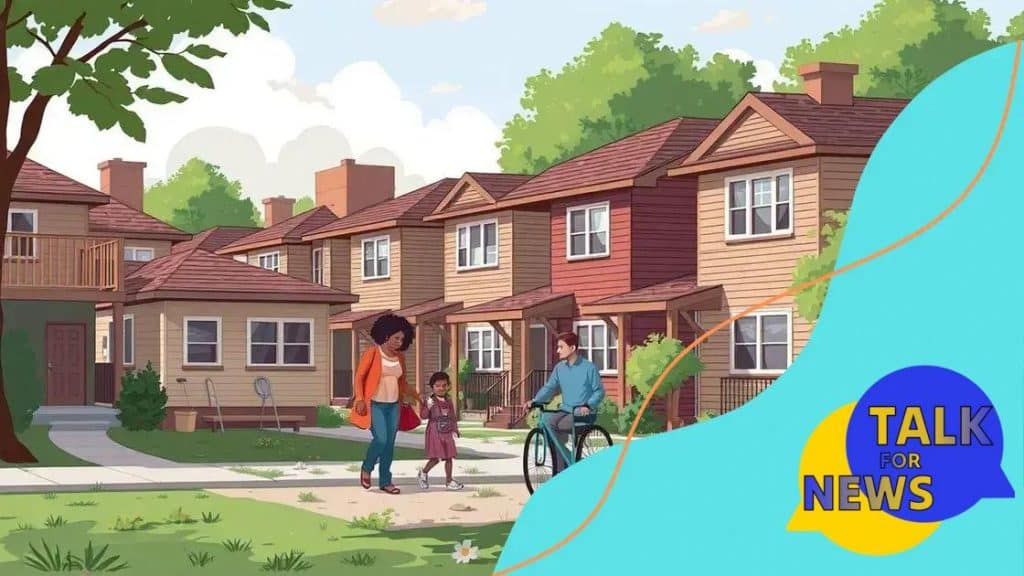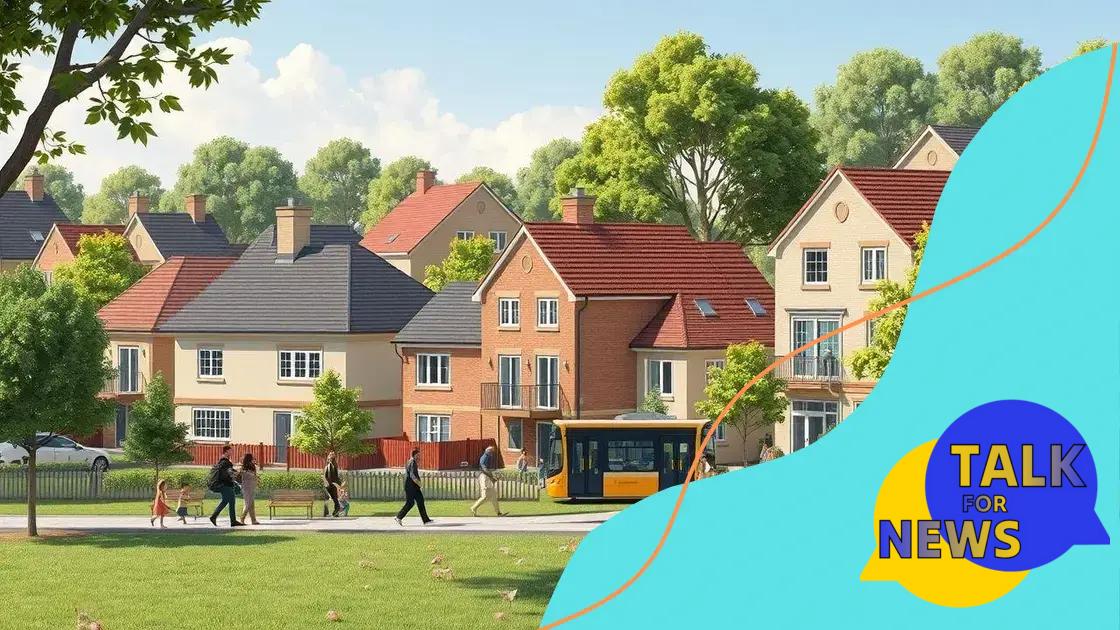Federal subsidies for low-income housing in urban areas

Anúncios
Federal subsidies for low-income housing in urban areas provide critical financial assistance to eligible families, enabling them to access safe and affordable living conditions amidst growing urban challenges.
Federal subsidies for low-income housing in urban areas offer critical support for families struggling to find safe and affordable living conditions. Have you ever wondered how these programs shape communities and impact residents’ lives? Let’s dive in!
Anúncios
Understanding federal subsidies for housing
When it comes to affordable living, federal subsidies for housing play a crucial role. These programs aim to assist low-income families in accessing safe and decent housing. Understanding how these subsidies work can help individuals and communities leverage these resources for positive change.
What Are Federal Housing Subsidies?
Federal housing subsidies are financial aids provided by the government to lower the cost of housing for eligible families. These subsidies can take various forms, such as direct rental assistance or funding for affordable housing construction. Often, these supports are designed to address the unique challenges faced by urban populations.
Types of Housing Assistance
- Housing Choice Voucher Program: This program allows families to choose their housing while receiving rental assistance directly from the government.
- Public Housing: Government-owned properties that provide affordable housing options for low-income households.
- Tax Credits: Incentives for developers to create affordable housing units through programs like the Low-Income Housing Tax Credit (LIHTC).
- Community Development Block Grants: Funds provided to local governments to support various community development initiatives, including affordable housing.
Anúncios
Each of these types targets different aspects of the housing market, allowing for a more comprehensive approach to solving housing issues in urban areas. They help bridge the gap between income levels and housing costs, making a significant difference in the lives of many.
Moreover, the impact of these subsidies can extend beyond individual families. By supporting low-income housing, these programs can contribute to stable neighborhoods and vibrant communities. When people have the resources to secure housing, they can focus on improving other areas of their lives—like education and employment.
In addition to economic benefits, federal subsidies for housing also encourage community engagement and development. Residents are more likely to invest in their neighborhoods when they feel secure in their homes. By knowing that they have a stable place to live, families can build stronger connections within their communities.
Nevertheless, navigating the world of federal housing subsidies can be complex. Many families may not be aware of the programs available or might find the application process daunting. Public outreach and education play pivotal roles in helping potential beneficiaries understand and access these vital resources.
In summary, understanding federal subsidies for housing is essential for both individuals and communities. These supports are not just financial aids but vital tools for enhancing overall community well-being and stability, enabling families to thrive in urban contexts.
Who benefits from low-income housing subsidies?
Low-income housing subsidies are designed to provide essential support to various groups in need, making housing more accessible. Understanding who benefits from these programs can highlight their importance and impact in our communities.
Families with Low Income
Families struggling to make ends meet often find it challenging to afford safe and decent housing. Low-income housing subsidies help these families allocate more of their limited resources to other necessities like food, healthcare, and education. By lowering housing costs, these subsidies enable families to invest in their futures.
Elderly Individuals
The elderly population, especially those on fixed incomes, can greatly benefit from housing subsidies. Many retirees may find their pensions insufficient to cover rising housing costs. Housing assistance programs can provide stability and security, allowing them to live with dignity in their later years.
Single Parents and Caregivers
Single parents often face unique financial challenges while raising children alone. Subsidies for low-income housing support these families by providing affordable living options. This assistance can alleviate some financial pressure, allowing these parents to focus more on their children’s development and well-being.
- Low-income workers: Many individuals working multiple jobs struggle to afford housing costs.
- Homeless individuals: Housing subsidies can help provide stable living conditions for those facing homelessness.
- Disabled individuals: This group often requires additional support for housing related to accessibility needs.
- Veterans: Many veterans may need financial assistance to secure suitable housing post-service.
The benefits of these subsidies extend to the broader community as well. By providing stable housing, local economies can thrive, and neighborhoods can become more vibrant. When families feel secure in their homes, they are more likely to participate in community activities and contribute to local initiatives.
Moreover, understanding the diverse group of beneficiaries can encourage more people to advocate for and support these essential programs. Every individual deserves a chance to live in a safe and stable environment, and housing subsidies create that opportunity.
The role of urban development in housing assistance

Urban development plays a critical role in housing assistance by shaping the environments where low-income families can live and thrive. As cities grow, so do the challenges related to affordable housing. Understanding how urban development influences these dynamics is key to finding long-term solutions.
Planning and Policy
Effective urban planning involves creating policies that prioritize affordable housing in development projects. Local governments must consider how to integrate low-income housing into their city plans. This may include zoning laws that allow for diverse housing types, ensuring new developments meet various community needs.
Infrastructure Improvements
Urban development often involves upgrading infrastructure, which can enhance accessibility to housing. Improvements in public transit, roads, and utilities make areas more attractive for diverse housing options. When neighborhoods are easier to navigate, they become more desirable for families seeking affordable housing options.
- Access to transportation: Easily reachable public transport links can help residents commute easily to work or school.
- Community spaces: Parks and recreational facilities encourage families to engage with their neighborhoods.
- Job opportunities: New developments can attract businesses, providing jobs within proximity to housing.
- Health services: Access to healthcare facilities is critical for supporting residents’ well-being.
Furthermore, urban development can foster community engagement. When cities invest in creating safe and attractive neighborhoods, residents are more likely to participate in local activities. This sense of community contributes to the effectiveness of housing assistance programs.
However, it’s essential to address potential pitfalls in urban development. Gentrification, for example, can displace low-income communities and exacerbate housing issues. Ensuring that low-income residents are included in development discussions is crucial for equitable outcomes.
In addition, developers are encouraged to collaborate with local organizations to enhance housing assistance. This collaboration can lead to innovative solutions that meet the real needs of the community while ensuring that new projects are beneficial for everyone.
Challenges in accessing federal housing subsidies
Accessing federal housing subsidies can be a complex process for many individuals and families. There are several challenges that people face, making it difficult to take advantage of these essential programs designed to foster stable living conditions.
Bureaucratic Barriers
One significant challenge is the bureaucracy involved in applying for assistance. Many applicants encounter long and confusing application processes. This can discourage eligible individuals from pursuing the help they need. Forms and eligibility requirements often change, leading to further complications for prospective applicants.
Awareness and Information
A lack of information about available federal housing subsidies is another barrier. Many low-income families may not be aware of the programs that exist or how to apply. Without proper outreach and education, these families cannot benefit from the assistance tailored to their needs.
- Miscommunication: Information is often not communicated effectively, leading to misunderstandings about eligibility and application procedures.
- Limited resources: Community resources that help individuals apply may be scarce, especially in rural areas.
- Language barriers: Non-English speakers may find it difficult to access information and apply for subsidies.
- Digital divide: Many application processes require internet access, which can pose problems for those without reliable connectivity.
Another challenge relates to the availability of suitable housing. Even when families qualify for housing subsidies, there may be insufficient affordable units in their area. This mismatch can leave eligible families without the housing they desperately need.
Additionally, stigma surrounding housing assistance can discourage individuals from seeking the help they are entitled to receive. Many people may feel embarrassed about needing assistance, fearing judgment from their peers or communities.
Moreover, fluctuating government budgets can impact the consistency of funding for these programs. When funding is limited, the availability of subsidies can be reduced, further complicating access for families in need.
Being aware of these challenges is the first step toward addressing them. Advocacy for clearer policies and better outreach can significantly improve access to federal housing subsidies.
Future of low-income housing in urban areas
The future of low-income housing in urban areas is increasingly vital as cities expand and the demand for affordable living options grows. Addressing this issue will require innovative strategies and community engagement.
Trends in Low-Income Housing Development
One significant trend is the increasing integration of mixed-income developments. These projects aim to combine various income levels within the same community, promoting diversity and reducing segregation. By mixing affordable units with market-rate housing, cities can create thriving neighborhoods while ensuring low-income families have access to necessary resources.
Sustainable and Green Housing
Another key focus is on sustainable construction practices. Builders are beginning to prioritize eco-friendly materials and energy-efficient designs. By investing in sustainable housing, cities can reduce long-term costs for residents and promote healthier living environments. Green initiatives not only protect the environment but can also lower utility bills for families.
- Smart technologies: Integrating smart home technology can improve energy efficiency and provide better living conditions.
- Community involvement: Engaging residents in the planning process helps ensure that their needs are met.
- Public-private partnerships: Collaborations between government and private developers can increase resource availability for housing projects.
- Transit-oriented development: Building near public transit hubs enhances accessibility for low-income families.
Moreover, advocacy for policies that support funding and resources for low-income housing is crucial. Policymakers need to prioritize these initiatives to ensure that federal subsidies remain accessible and effective. For example, creating more flexible zoning laws can encourage developers to build affordable housing units.
Education also plays a critical role in shaping the future of low-income housing. By raising awareness about available programs and resources, communities can better support residents in navigating housing challenges. Workshops and information sessions can empower families to access the help they need.
As we look ahead, innovative solutions and collaborative efforts will be essential in shaping the landscape of low-income housing. By addressing the needs of diverse populations while prioritizing sustainability, cities can ensure that all residents have access to safe and affordable housing.
FAQ – Frequently Asked Questions about Low-Income Housing in Urban Areas
What are federal housing subsidies?
Federal housing subsidies are financial aids provided by the government to help low-income families afford safe and decent housing.
Who qualifies for low-income housing assistance?
Eligibility for low-income housing assistance typically depends on income level, family size, and local housing market conditions.
What challenges do families face when accessing these subsidies?
Families often encounter bureaucratic barriers, lack of awareness about programs, and stigma that may discourage them from seeking assistance.
How can communities improve access to low-income housing?
Communities can enhance access by increasing awareness, involving residents in planning, and advocating for more supportive policies and resources.





